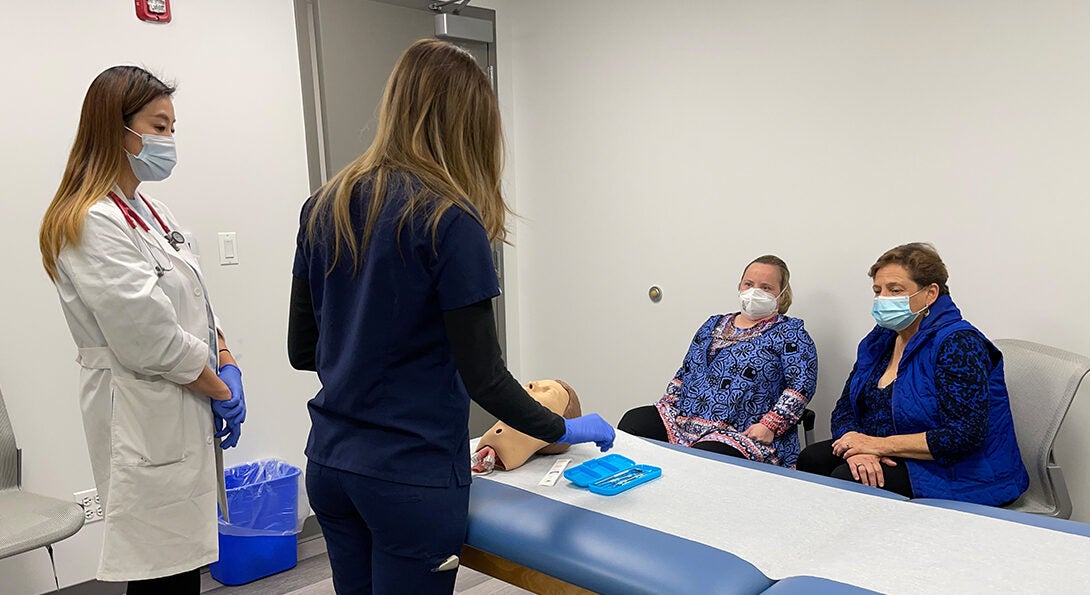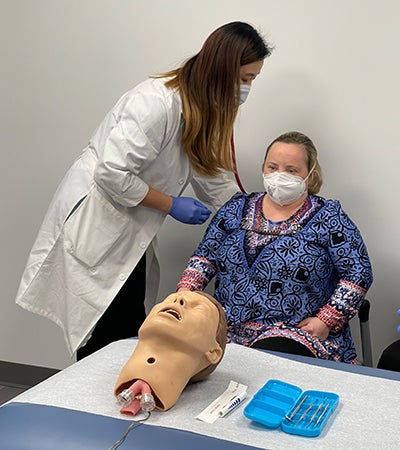New training focuses on patients with disabilities

UIC colleges of Nursing, Pharmacy and Dentistry collaborate to create opportunities for students to practice simulated interactions with patients with disabilities Heading link
Bridget Brown has acted alongside the likes of Miley Cyrus and William H. Macy, but today her acting partner is her mom.
Brown, who has Down syndrome, is playing a standardized patient in the UIC College of Nursing’s Schwartz Lab. Her character, “Dana Cortez,” has arrived in an exam room with severe pain on the right side of her jaw. “Joyce,” played by her mom, Nancy Brown, accompanies her for support.
As part of a case study, DNP student Eun Jo Michelle Park, BSN ’16, RN, and dentistry student Nikol Manov must assess Cortez and diagnose the cause of the pain.
“It’s terrible pain,” says Brown, touching the side of her mouth. “I’m taking aspirin for it, but it doesn’t really help.”
When Manov goes to examine her mouth, Brown reminds her, “don’t touch there, it’s really sore on the right side.”
The scene is the result of an interprofessional collaboration between the Colleges of Nursing, Dentistry and Pharmacy, featuring patients who are played by actors with intellectual or physical disabilities. In addition to Brown, there are nine other actors employed to play versions of “Dana,” in which she has disabilities such as cerebral palsy and aphasia.
Gaining exposure to patients with disabilities Heading link

The collaboration came about because Brown’s father, Blase Brown, DDS, a UIC College of Dentistry professor, was looking for more opportunities to train his students to work with patients with disabilities. At the same time, Susan Kilroy, PhD ’20, RN, director of the Clinical Learning Resource Center at UIC Nursing, wanted to give her students more exposure to interprofessional situations. They decided to combine the two ideas into one project.
“Most of our health care students don’t have a lot of opportunities to interact with patients that have intellectual, developmental and other disabilities,” says Blase Brown. “In thinking through that, here at UIC, we’ve been able to create more opportunities for our students.”
The program piloted this fall with 71 pharmacy, dentistry and nursing students. As part of the program, students complete a series of online learning modules about caring for people with disabilities. Then they get assigned to work together on one of two simulation cases – including the “Dana Cortez” case –in-person or via telehealth.
Funding for the paid actors comes from a grant from the IPE (interprofessional education) steering committee and the UIC College of Nursing Faculty Catalyst Fund, a philanthropically supported fund.
Blase Brown says the experience gives students a chance to think through differences in caring for this population, such as deficits in communication, getting consent and building rapport.
“If they haven’t had a lot of experience interacting with people with a variety of disabilities, they might not change what they do,” Blase Brown says. “Their care might look exactly the same way it would look with a non-disabled patient, but maybe not with the same outcomes. [We want them to develop] a level of comfort and empathy for individuals with disabilities, rather than feeling inadequate or nervous about interacting or treating them.”
Feedback session is critical
Park, who is training to be a family nurse practitioner, hadn’t previously had much experience with patients with disabilities and was a little nervous when she started. She said the presence of Joyce, the health coach, added complexity to the scenario.
“Incorporating the caretaker into the visit was another part of the experience to be mindful of, which I wasn’t thinking about before,” she says. “I was focused on the patient, but the [support person] is part of the care team as well. That dynamic is important in approaching patients.”
After the session, Kilroy, who had been observing from an attached control room with a one-way mirror, gathered the students together with Bridget Brown and her mom. She revealed the correct diagnosis – Trigeminal Neuralogia (a nerve pain) – and also prompted the participants to share feedback about how they felt, what went well, and what could be improved upon.
Employing actors with disabilities, rather than actors playing individuals with disabilities, represents an important shift. It recognizes that a disabled actor can provide insight into the real experience of people with disabilities during health care interactions. It infuses the simulation – which is intended to mimic a real health care interaction as closely as possible – with a higher level of authenticity.
Park says this exercise gave her an opportunity to hear Bridget’s perspective as the “patient” in the scenario.
“Listening to the patient is very important,” she says. “I might need to give more time so they can go at their own pace; so that I can understand them more, and so they can explain themselves more.”
Kilroy says the students also value getting the perspective of other disciplines.
“Dentistry students will say, ‘I love listening to the nurse practitioner [NP] student interviewing the patient. I had no idea the way they took a history,’” Kilroy says. “The NP student will say, ‘I loved having the pharmacist here. It was so nice to have someone who could advise about the interactions of drugs.’”
Inclusion is important
Bridget Brown says it’s important for people with disabilities to be included in their own health care.
“I think the message beneath that is: people with disabilities want to take care of their own bodies,” she says.
Brown and the other actors were paid to attend workshops over the summer, where they practiced scripts about their cases with UIC Nursing’s nursing simulation specialist Chris Karczmar. He trained them to share key pieces of information, although they can also ad lib where needed. The health coaches who accompany the actors in the sims can also help prompt the standardized patients if they forget things – just like a support person would at a real appointment.
Brown shares her perspective that providers should keep appointments short.
“Some people with disabilities have [short attention spans]. If it becomes too long, they may get fidgety,” she says. “They won’t stay still. [For instance,] it’s harder for them to stay in the chair dentist visits.”
Brown also has an internship in the Schwartz Lab through the UIC Co-Operative Career Experience Certificate program in the College of Applied Health Sciences, which gives her an opportunity to earn college credits and gain work experience.
She is passionate about both health care and acting. Brown has acted in 26 community theater productions, in addition to film and television productions, like 2012’s “LOL” with Miley Cyrus, 2016’s “Wiener-Dog” with Kieran Culkin and Greta Gerwig, “Shameless” with William H. Macy and “Chicago Justice” with John Seda.
Brown says she also likes it when her own providers are curious about her life because it establishes a sense of familiarity.
“The most important thing to do is to advocate for inclusion, advocate for inclusion for all people with disabilities,” she says.
You can see Bridget Brown in her latest role in the Star Wars fan film, “No Easy Target,” on the big screen at the Music Box Theater on Dec. 29.